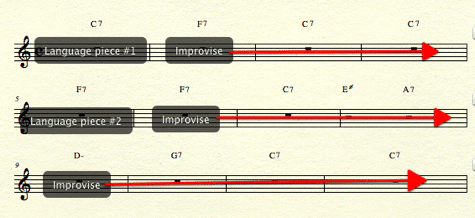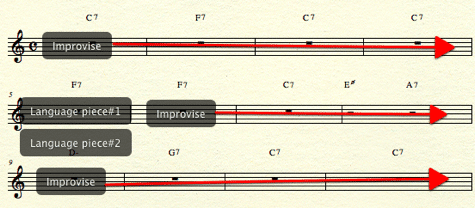When we practice jazz improvisation, we zoom in on one area of study so much that we often lose sight of the whole. How do we practice in this truly focused way, while simultaneously train ourselves to perform in a way that expresses all of what we know? In other words, how can we shift our perspective from a one-pointed zoomed in view to a wide angle lens where we’re capable of drawing from many concepts, lines and techniques?
The answer: practice mixing.
Mixing is just that. You practice mixing multiple techniques during a chorus or several choruses of improvisation. By doing this, you learn how to widen your gaze and not get hung up on playing the same thing every time around.
The more you learn to mix everything you practice, the more it will be available in live performance as it will be natural for you to move from one idea to another, or to sprinkle in some new concept you’ve been working on at just the right moment.
What to mix
What can you “mix”? Well, when you think about it, in general, anything you play is either a piece of language, or a concept. Really, even a piece of jazz language is an example of concepts in action, so essentially everything is a concept, but for sake of clarity, I prefer to think of language and concepts as two complimentary entities.
So, you can mix:
- language with language
- language with concepts
- concepts with concepts
These are all equal in terms of their relative importance. You should practice all of them.
How to practice mixing
There are two primary ways to practice mixing.
The first way to practice mixing is to choose one of the combinations above and pick two distinct areas of a tune to implement them over. For example, supposing I select the “language with language” mixing option. I’d then take language piece #1 and find a place in a blues where I could play it, and then take language piece #2 and find different place where I could put it during the same chorus.
If I selected two dominant pieces of language maybe it would like this:
This is just one of many ways you could practice mixing. By interspersing your predetermined parts with improvised parts, you learn to integrate the language or concepts naturally into your playing.
You could instead choose to only use predetermined material throughout the entire chorus, or you could use three pieces of language. There’s many options, but the gist is: select multiple concepts or lines and use them in different spots during the same chorus.
The second primary way to practice mixing is to use two pieces of language, two concepts, or one piece of language and a concept over the same area of a tune during different choruses.This might look something like this:
Again, this is just one sample of many ways you could chose to implement this exercise. Another option would be to cut down on how much you’re improvising during a chorus, and any time you can possibly use one of the pieces of language, use them; alternate which line you play each time you encounter a place where you could harmonically implement the language, especially from chorus to chorus.
Which one of these two mixing exercises is better?
They’re both great and they both yield slightly different skills. The first exercise teaches you how to think of multiple places in a tune in a static way. It introduces you to the idea of utilizing two techniques in a very prescribed manner, which will help ingrain the concepts and lines in your ear, fingers, and mind, while teaching you how to use them in real-world context.
The second exercise is more dynamic as you’re thinking about the same part of a tune in different ways each time you encounter it. This is slightly more difficult, but will help you learn to intuitively mix up your habits, ultimately leading to a more fresh overall concept.
Start with the first exercise as it will introduce you to the notion of mixing, then proceed to the second exercise.
How mixing translates to live performance
Live performance is all about listening to your inner voice and letting go, while at the same time, perhaps, having some sort of a road-map, or a general idea of where you want to take the solo. Now, everybody has a different balance of how they approach this.
Some people like to completely let go and see what comes out. Actually, to be more accurate, it be “hear” what comes out…
Others are known for planning out the general architecture of a solo before they play it.
Where ever you may lie on this spectrum is completely up to you, but no matter how you want to approach things, practicing mixing techniques allows you to get there because mixing takes everything you’re working on and helps bridge the gap between practice and live performance.
During live performance you want to be able to access anything you’ve ever worked on. Well how do you do this if you haven’t practiced mixing everything you’ve worked on in the practice room?
Take the exercises presented in this article and mix your language with other language, your concepts with other concepts, and your language with your concepts. In doing so, you’ll transition all your musical ideas to the band stand, which is where they belong.












